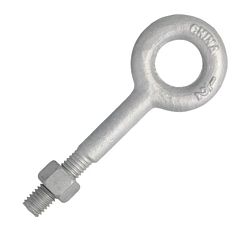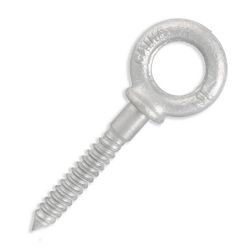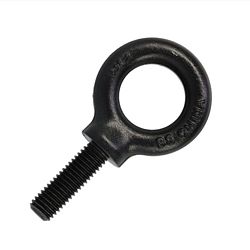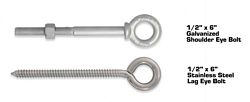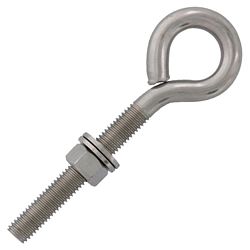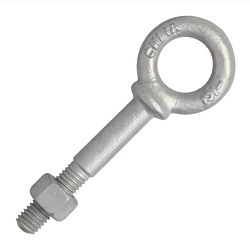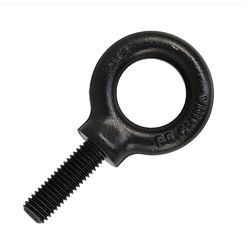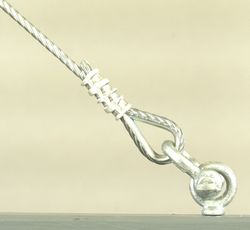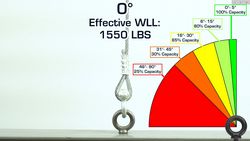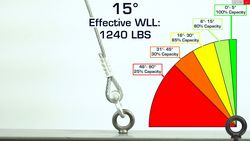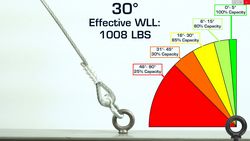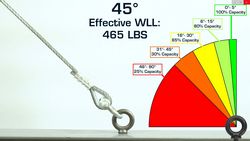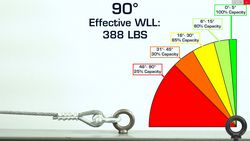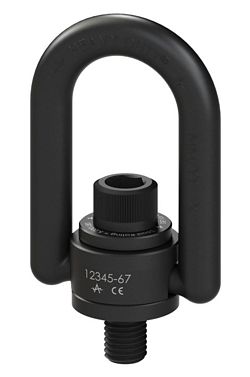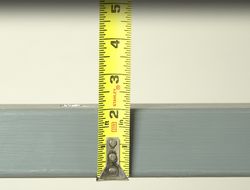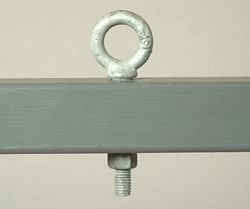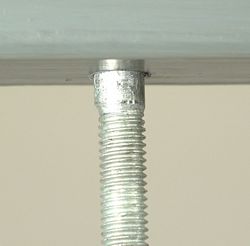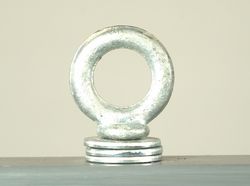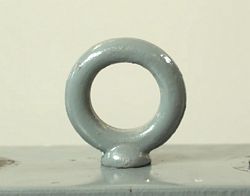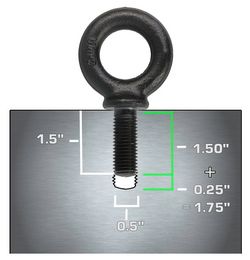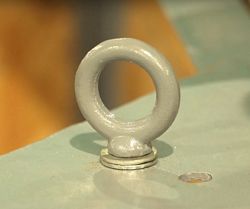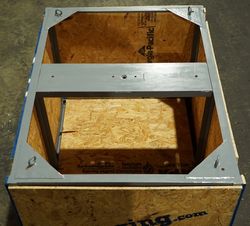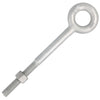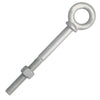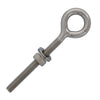There are four main styles of
eye bolts available
in a variety of sizes and finishes:

These fittings are made up of a threaded shank with a loop or eye at one
end. The eye bolt is inserted through a hole and secured on the back side
with a nut. Regular eye bolts have a working load limit which should be
taken into consideration when used for lifting or supporting an overhead
load. They are designed for straight line loading only and can bend or
break if loaded at angles.
Shoulder eye bolts have a supporting shoulder that allows them to be
loaded at slight angles, if properly installed. These fittings are very
versatile and are designed to be inserted through a hole and secured on
the back side with the provided nut. Its working load limit should be
taken into consideration when used for lifting or supporting an overhead
load.
Lag eye bolts have threads designed to screw into wood. They don’t have
a working load limit because their strength is dependent on the species
and condition of the wood it is screwed into. For example: A lag eye
bolt will hold more load when screwed into a new oak board, compared to
an old pine fence post.
Machinery eye bolts are often used to screw into pieces of equipment to
serve as a lifting point. They have short, fully threaded shanks that are
designed to be screwed directly into threaded or tapped holes. These
fittings have a shoulder allowing for lifting at slight angles, and a
listed working load limit.
The size designation for eye bolts are common across all types.
This is a ½” x 6" shoulder eye bolt and a ½” x 6" Stainless steel lag eye
bolt.
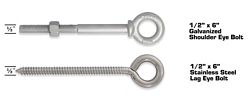
The ½” measurement references the diameter of the shank.
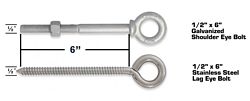
The 6” measurement refers to the length of the shank.
The larger the diameter of the shank, the larger the working load limit. A
longer shank length allows you to go through thicker objects. The threaded
portion varies for each eye bolt, so visit our website if you need more
detailed dimensions of our eye bolts.
Strength and Durability from Different Manufacturing Methods
An indicator for how strong or durable an eye bolt will be is the way it is manufactured. Eyebolts are manufactured in a variety of ways to suit users' needs for cost and durability. Always refer to the working load limit first when determining an eyebolt's suitability for your application. Drop forged or cast eyes are recommended for critical applications. These are manufacturing methods in order of least durable to most durable.
Formed
Formed eyebolts are the most cost-effective types and are made by bending a straight rod into an eyebolt shape.
Formed and Welded
The same process as a formed eyebolt, but the bent eye is welded shut for added strength and durability.
Cast Steel
These eyebolts are a cost-effective stainless steel option and have precision cast eyelets with welded threaded shanks.
Drop Forged
The most durable of all eyebolt types, these are drop forged into their shape from superheated steel. This process provides the strongest grain structure inside the steel and a continuous connection between the eye and the shank.
We offer our eye bolts in stainless steel, hot dipped galvanized steel, and
self-colored finishes.
Stainless Steel is the
most corrosion resistant and has the best-looking finish.
Angular Loading
Oftentimes, loads are applied to eye bolts at an angle and for these types
of applications shoulder eye bolts should only be used.
Loading at an angle can alter the working load limit of the eye bolt.
It is important to note that all eye bolts are designed for loading with the
axis at the center of the eye. They should never be loaded perpendicular to
that axis because they are likely to bend and break.
Eye Bolt Working Load Limit Effects
due to Angular Loading
The degree of angle of your load can have a big effect on the working load
limit of the eye bolt.
This cable is at 0 degrees. At 0 to 5 degrees, the eye bolt is rated at 100
percent of its working load limit. In this case, the catalog working load
limit of this 3/8th inch eye bolt is 1,550 pounds.
At 15 degrees, the working load limit is reduced by 20% and the effective
working load limit of the eye bolt becomes 1240 pounds, which is 80% of the
original rated capacity.
30 degrees makes for 65% of the original rated capacity.
45 degrees makes for 30% of the original rated capacity.
90 degrees makes for 25 % of the original rated capacity. The 75% reduction
in capacity makes the effective working load limit only 388 lbs.
Because of the effect that angles have on eye bolts and working load limits,
we recommend using swivel hoist rings as an alternative choice. The
advantage to them over eye bolts is that they maintain 100 percent of the
working load limit at any angle from 0 to 90 degrees.
First, determine thickness of what the eye bolt will be going through.
Then, choose an eye bolt with a shank long enough so that the threads
protrude on the back side and allow the nut to be tightened properly.
If the unthreaded portion of the shank protrudes below the bottom surface
and does not allow the nut to be tightened, you can use washers to fill the
space of the unthreaded portion of the shank.
Machinery eye bolts are primarily intended to be installed into tapped
holes. The eye bolts are threaded to UNC standard and the hole needs to be
tapped accordingly to ensure the shoulder will be firmly seated against the
object to be lifted.
When drilling and tapping the hole for the eye bolt, the hole depth should
be the length of the shank plus one half the diameter of the shank.
As mentioned earlier, eye bolts are to be used so that loads are applied
about the axis of the eye.
When installing machinery eye bolts it may be necessary to add washers to
shim the eye bolt to achieve the correct alignment.
We will illustrate this by attaching 4 machinery eye bolts to each corner of
this lifting box. Note that all the eye bolts are NOT “in line.”
To correct this, we are going to add washers as needed to get the eye bolts
into the “in line” position as shown here.
General Safety Precautions
When selecting an eye bolt, it is important to consider the following
factors:
-
The load capacity: The eye bolt must be able to
support the weight of the load it will be lifting.
-
The material of the eye bolt: The eye bolt must be
made of a material that is strong enough to support the load and that is
compatible with the material it will be attached to.
-
The type of attachment: The eye bolt must be able
to be attached to the material it will be used with.
Load Capacity
The load capacity of an eye bolt is
determined by its size and material. The larger the eye bolt, the more
weight it can support. The material of the eye bolt also affects its load
capacity. For example, a steel eye bolt can support more weight than an
aluminum eye bolt of the same size.
Material
The material of the eye bolt matters
because it must be strong enough to support the load and that its
compatible with the material it'll be attached to. Ex: a steel eye bolt
should not be used to attach to a wooden structure.
Type of Attachment
The type of attachment is
important because the eye bolt must be able to be attached to the material
it'll be used with. Ex: an eye bolt with a threaded shank can be screwed
into a threaded hole, while an eye bolt with a plain shank can be attached
with a nut.
Working Load Limit (WLL)
the WLL of an eye bolt is
the maximum amount of weight it can safely support. It's important to
always check the WLL of an eye bolt before using it. The WLL is typically
stamped onto the eye bolt.
Safety
Use eye bolts in a safe and responsible
manner. Here are some safety tips:
-
Always make sure the eye bolt is properly sized for the load you'll be
lifting.
- Use a wrench to tighten the nut on the eye bolt.
- Do not overload the eye bolt.
- Do not load the eye bolt at an angle.

Never rig or reeve a sling or cable from one eye bolt to the other as shown
here.
We hope this video has helped you with the selection and installation of
eye bolts for your rigging assembly. If you have any further questions,
please Contact Us.
Please Subscribe to our
YouTube Channel
for more information on various rigging topics.


